Pioneer DJ has been synonymous with the CDJ and club market for over a decade. Their range of CDJs and 900NXS mixers are the de-facto installs in many clubs and festival booths worldwide. However, their 2-channel scratch offerings haven’t had the same market dominance over the years. Of all their attempts, the DJM-S9 was arguably their most successful 2-channel scratch mixer. A stellar crossfader and an intuitive and powerful effects section were the main selling points. They were so successful with the S9 that subsequent competitors borrowed liberally from Pioneer DJ’s design in the last few years.
Despite their success, there was always a contingent of scratch and hip-hop/open-format DJs that avoided the S9. The lack of independent pads, the less-than-stellar sound quality, or the plastic-y build turned off many DJs. A few years later, offerings from companies like a rejuvenated Rane or Reloop appeared – many addressing the deficiencies of the DJM-S9.
Pioneer DJ remained quiet about 2-channel mixers until the DJM-S11 burst onto the scene late last year. While an incredible piece of design and engineering, it was a little overkill for some fans of the original S9. Many DJs were expecting a DJM-S9 MK2, and instead, they got Pioneer DJ’s answer to the Rane Seventy-Two. Filled with some considered superfluous features, the S11 also sported a high price tag to match.
Back in September, a leaked catalog page showed the DJM-S11, the DJM-V10-LF, and what could be an updated DJM-S9. While the S11 and V10-LF saw the light of day shortly later, the mysterious 3rd mixer was nowhere to be seen. Then, late last month, Pioneer DJ once again flipped the script and officially announced something unexpected. Instead of an S9 MK2 or an S10, it was a DJM-S7.
So: is this the spiritual successor to the DJM-S9 that we’ve all been waiting for?
The layout
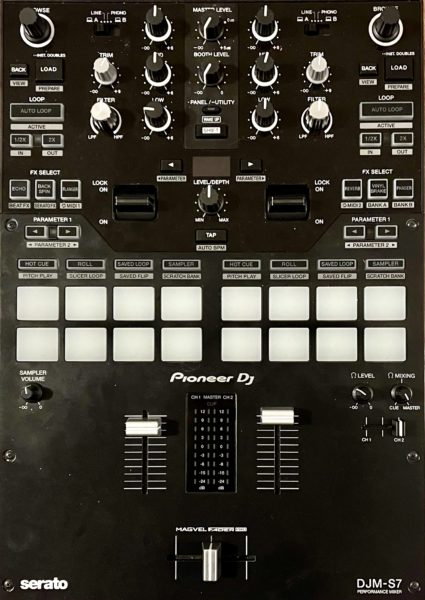
There aren’t many surprises when it comes to the DJM-S7 layout, as it looks very similar to the DJM-S9. Most notably, the Trim and Filters’ placement is off to the side like the DJM-S9. In fact, most of the upper part of the mixer looks about the same as the DJM-S9. There are some minor changes: the line switcher is a switch instead of a knob, the load button is the large square button seen on the S11 instead of a smaller button, and the placement of buttons has moved slightly.
But there are a few differences worth noting. One of the biggest is the lower half of the mixer is almost identical to the DJM-S11. The effects section is the other most significant change. The effects now sport two banks of 3 buttons instead of two banks 6. They also removed the routing buttons surrounding the Tap button.
Beyond that, anyone familiar with the DJM-S9 should feel right at home on the DJM-S7.
Build Quality
The build quality of the DJM-S7 is, for the most part, standard Pioneer DJ fare. While it mainly uses plastic, it has a solid feel. I’m not the biggest fan of plastic builds, but Pioneer DJ has proven itself in the field at this point. In addition to the plastic, some other things irk me. For instance, the finish on the back panel scratches easily. The mirrored finish on the top panel also attracts its fair share of smudges.
Pioneer DJ has also cut some additional corners. The upfaders are also an inferior quality to S9/S11 – feeling more flimsy than before. The bumpers at the front are no longer rubber but hard plastic. The knobs feel a little cheaper as well. Overall, I would say it’s a step down from the DJM-S9 in build – but only by a little bit. Many of the components seem the same as the S11, though – like the pads and buttons.
Despite my complaints, Pioneer DJ tends to be reliable in terms of build overall, even if it doesn’t feel as sturdy as some other companies.
Sound Quality
Once again, sound quality is ultimately a subjective thing. These are my personal opinions based primarily on years of being a DJ, music producer, and live sound engineer.
I think the sound quality of the DJM-S7 is pretty good. After years of giving Pioneer DJ a hard time in terms of their sound, they have finally made strides. It has a fairly neutral sound to it, and everything sounds balanced. Compared to the S9 – long criticized for its fatiguing and harsh sound – the S7 is unquestionably an improvement.
Comparing it directly to the DJM-S11, I find it lacks a bit in the mid presence and overall clarity. It is a subtle difference, though. It’s a little off-putting seeing a lower quality sound card in the DJM-S7 vs. the S11, though. Especially considering that Rane put identical cards and DACs between the Seventy-Two and Seventy. That said, the diminished sound quality is barely noticeable unless you compare them side by side.
There is still a certain quality to the Pioneer DJ sound that I find a little too clinical. I have also spoken about the EQs on Pioneer DJ mixers before, and I still don’t like them. Something about the EQs’ cut and crossover makes everything sound a little thin to my ear. While the DJM-S7 still ranks below a few companies, I don’t actively dislike the sound like on their earlier gear. That’s progress!
Phono Preamps
Phono preamps have never been Pioneer DJ’s strong suit, and I had low expectations for the S7. While many seemed to like the preamps on the S11, they didn’t sound great to me either. Surprisingly, I find I prefer the preamps on the DJM-S7 – which offer a bit more clarity to my ear. It’s still not the best phono preamps I’ve heard on a DJ mixer. That honour goes to companies like Allen & Heath, Rane, and Ecler. It’s still better than the preamps I’ve heard in Pioneer DJ’s lower-end mixers or controllers.
Pads and Buttons
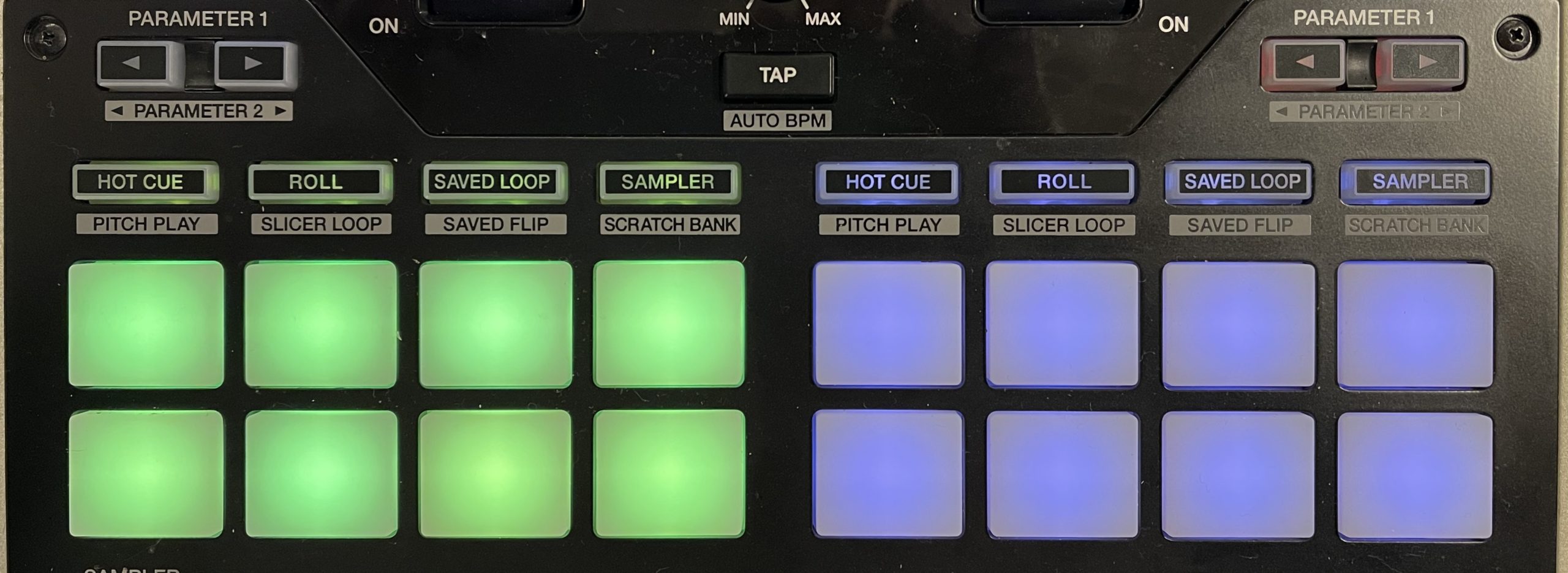
The pads and buttons are the same high quality as almost all Pioneer DJ gear. The pads don’t have much give to them, but they feel very satisfying and responsive. The buttons are the standard Pioneer DJ components found in all their gear – from the cheapest to the highest end.
Functionality-wise, the pad section is identical to the DJM-S11. Every single pad mode available in the S11 is also available on the S7. Often, companies remove certain features to artificially increase the value of their top-end stuff (Pioneer DJ included). The pad modes are, thankfully, not one of those things. The only differences from the S11 are the smaller pads and not having a Smooth Echo feature.
All 12 modes exist, including the standards like Hot Cue and Loop Roll. Newer features like Scratch Bank, and some exclusive features like Gated Cue and Cue Loop are also available. The Split Pad function also made it to the DJM S7. This allows you to split the top and bottom half of the pads into different functions. Each pad mode has a user-mode for custom mapping (a total of 4 custom pad pages). In a very nice touch, the MIDI CCs are identical to the DJM-S11, allowing custom mappings to transfer between mixers.
Effects

The effects section on the DJM-S7 should be very familiar to anyone coming from an S9. The paddles, button placement, and features are the same, with only a few tweaks. The most notable difference is the smaller number of effect buttons.
Controls
At first glance, it does look like Pioneer DJ neutered the effects controls slightly. 6 buttons are less than 12, after all. But closer inspection reveals that the controls actually offer a lot more than that of the DJM-S9. You can choose from 6 preset pages – one for each button. The hardware effects are exactly what you see printed on the buttons. The software effects display the proper names on the smaller screen. The next two preset modes are the new Loop MIDI features that we will get into in a bit. The customizable banks fill out the remaining 2 modes. This allows you to set any of the 22 hardware effects and the software or Loop MIDI effects.
Effects Stacking
Similar to the S11, it is possible to stack multiple software effects. You can also add hardware effects or Loop MIDI effects to the chain. This results in some truly epic combinations of effects and Serato functions. Unfortunately, stacking effects from different sections require a little more effort than on an S11. You must use the Utility app to stack hardware, software, and Loop MIDI effects. Stacking was not previously available on the S9, so that’s a nice improvement.
Routing
The ability to assign effects to the Aux input and the dedicated Sampler output is also missing from the DJM-S7. While it’s possible to apply effects to the Sampler, you must assign the sampler to one of the DJ channels -which isn’t ideal.
Tempo Tap
The Tap button remains in the familiar spot – and maintains the fantastic smoothing algorithm for tempo tapping.
Loop MIDI
Loop MIDI is one of those crazy features that Pioneer DJ only adds to one specific product. Think of the auto-scratch/Jazzy Jeff button exclusive to the DDJ SB3, the Smooth Echo exclusive to the DJM-S11, or the beat-synced color effects on the DJM-850. At its core, it does two things: it allows for custom mapping of MIDI functions to the paddles, and repeatedly “fires” those MIDI signals in time to the loaded tracks according to the Beat Effects settings. Think of it as the Note Repeat feature in an MPC. The DJM-S7 contains two banks of Loop MIDI mappings out of the box.
The default mappings found in Loop MIDI banks 1 and 2 are honestly a bit boring. They are assigned to things like Hot Cues, Sampler hits, pitch shifting, Censor, and my favourite, a mute effect (which can be used as a gate effect).
Thanks to the recent addition of MIDI multi-mapping to Serato, the combination of effects you can trigger are almost limitless. For instance, I could map a paddle to a Loop MIDI trigger which triggers a Loop Roll, the Censor feature, and a sample every 1/2 beat.
The feature comes to life when you start stacking it with additional software and hardware effects. Due to the stacking ability, you can add 1 hardware effect and as many software and Loop MIDI effects as you have buttons available.
If this sounds a little complicated, that’s because it is. This is not the most accessible feature, and I feel a lot of S7 owners will ignore it after a cursory glance. However, if you are willing to put the time in, it is very rewarding. The lack of any documentation or tutorials out there currently doesn’t help matters, though.
Faders
Like the DJM-S11, the S7 features an upgraded version of the contactless Magvel Pro crossfader found in the S9. While it feels the same, the materials are supposedly superior. Hopefully, this will be the end of the reports of broken Magvel Pros that weren’t uncommon on the S9.
Easily one of the top two scratch faders on the market, the Magvel Pro’s reputation speaks for itself. As I mentioned in my S11 review, it’s smooth, consistent, and cuts like a dream.
The upfaders on the DJM-S7 definitely took a hit in the quality department. The faders feel flimsier and cheaper and nowhere near the quality of the upfaders found on the S11 or S9. I particularly did not like the amount of lateral wiggle on the stems. Compared to the S9/S11 upfaders, they feel worse.
All the standard customizations for their faders are there: tension adjust, fader curves, and reverse switches are available on the front panel. You can also adjust the cut lag in the utility program on a laptop.
Pots

The pots are, again, standard Pioneer DJ quality. Metal stems (which I always prefer), and a decent amount of resistance. They seem different from the S11 and S9 as the stem orientation has changed. I didn’t notice much of a change in feel, though. There was slightly more of a lateral wiggle due to what I assume are cheaper components. The knobs follow the same scheme as the S9 and S11. The varying sizes and textures help differentiate the functions by feel as well.
Inputs/Outputs

The inputs and outputs are almost identical to the DJM-S11. Like most high-end mixers, it offers all three of the most popular cable types for the outputs. The XLR and RCA outputs share the same volume knob, while the Booth knob controls the 1/4” outputs. Also standard for this class of 2 channel mixers is the 2 USB ports to connect two laptops. In what is also rapidly becoming standard, there’s a built-in USB hub for controllers or players like Twelves or CDJs. The expected phono and line inputs for each channel are all there and an auxiliary RCA input. The grounding stems were the only glaring difference from the S11 – and I’ll get into this a little later.
Microphone
One of the more apparent overhauls compared to the S9 is the microphone section. The input is still the same combo XLR/1/4” jack, but the controls have seen a bit of a shift. While still located on the front plate, many features have been moved or outright removed. The most obvious being the loss of the mic echo effect, which was a favourite for many. The 2-band EQ has also been replaced by a single tone control knob – which is a step down for me. In a great design decision, the volume control has moved to the top of the section. This allows you to see your knob positioning a lot easier. A single, three-way switch also replaces the two switches found on the S9.
You can adjust the mic preferences within the onboard utility screen on the mixer. This allows you to adjust things like a limiter, low cut, filter, and customizing the talkover attenuation.
The mic preamp itself is alright. It’s not as clear as the S11 preamp, but did sound a bit better than the S9 preamp.

Bluetooth
Losing all those microphone features did manage to make room for the new Bluetooth functionality. You get a pairing button and a volume knob below the mic volume. The Bluetooth audio is routable to either channel or the master output via the mixer’s utility mode. It also won’t override any channels and instead play over any existing audio.
Rekordbox Support
The DJM-S7 fully supports plug-and-play for Rekordbox Performance mode. Like Serato, you can unlock the full suite of software without having to pay any additional fees. Like the DJM-S11, though, the S7 ultimately still feels optimized first and foremost for Serato.
Here’s what we liked.
Now, let’s dive into the things we liked about the DJM-S7.
Bluetooth
When I first read about this feature, it seemed cool – but not anything groundbreaking. My $200 Reloop SPIN has been sporting a Bluetooth receiver all this time as well. But after using it… where has this been all my life? It’s just great to link my phone to practice scratching without hooking up a laptop or needing to launch Serato. I can also send anything to my studio monitors from my phone or laptop without plugging in anything. There are also huge benefits at gigs (remember gigs?) for backup purposes and requests. The sheer convenience of it has just been great.
Audio input is the only thing it is capable of, though. There is no Bluetooth audio output available.
Magvel Pro Crossfader
The Magvel Pro is easily in my top 2 faders of all time. It’s just a fantastic fader to cut and scratch on. Check out a test run to get a better idea of the fader in action:
Loop MIDI in theory
I need to applaud Pioneer DJ for taking a risk and innovating with this feature. It is absolutely unique to the world of DJing and has some real depth to it.
Class Compliant Sound Card
Once again, I will reiterate that in 2021, every piece of audio gear should be class compliant these days. It’s taken forever to get Big Sur compatibility due to hardware drivers. Just more evidence as to why we need to make this a standard. Thankfully, the DJM-S7 is class-compliant, just like the S11.
Familliarity
While I was never an avid DJM-S9 user, I’ve had enough experience with it to know that most S9 users should feel comfortable and at ease on the DJM-S7. The layout is about as close to the S9 as you can get short of simply copying the design. Some DJs will wish that Pioneer DJ did just copy the S9 design and added the updated pad controls (and I’m one of them) – but the transition should be painless for most.
Workflow
While Pioneer DJ has had some questionable design decisions to me, the core functionality of their mixers is always eminently usable. Especially when it comes to effects and overall layout, it’s all straightforward and logical. Some of their deeper features and cryptic shortcuts are a little head-scratching, but the basics – as seen on the S7 – are easily accessible and simple to understand.
Price
As of this article’s writing, the DJM-S7 is the cheapest Serato, dual-USB, fully-featured, scratch mixer on the market. It’s even cheaper – at an MSRP of $1,399 – than the Reloop ELITE (when comparing US prices, at least). Compared to the S9, the lower pricing might explain the lower level of quality for some of the components. For the most part, you’re still getting a lot for your money. This aggressive pricing is a bit of a departure from Pioneer DJ, as they’re known for charging more than the competition, often for equal or fewer features. Hopefully, this is a sign of a new direction they’re taking.
Scratch Bank

I still can’t get over how great this feature is. This is the best Serato feature in years, and I hope more hardware gets this (especially the Reloop Elite). This has quickly become one of the features I cannot live without when I DJ.
…and where we’d hope to see improvements.
Unfortunately, no gear is perfect, and there are always things that could be improved. The following are some of the issues we had with the DJM-S7.
Lack of Effect Buttons
On paper, the effects on the S7 are far superior to those in the S9. There are more effects, the software and Loop MIDI effects are stackable, and it’s more flexible. This isn’t even counting the endless possibilities of custom mapping in the Loop MIDI feature. However, this makes the limited 6 buttons all the more frustrating to me.
I often forget to switch back to the default effects after experimenting with Loop MIDI effects or my custom banks. This results in many missed effect transitions. Ultimately, I decided that moving from the default bank (or one of the user banks) wasn’t worth the frustration.
The controls also force you to use the custom banks to experiment with effect combinations. This gets a little convoluted and requires more preparation time than if the 2 banks of 6 buttons were there.
Bugs
DJ gear is closer to tech products than music products these days. Every piece of gear has embedded processors and firmware these days. As a result, there are always kinks that need to be ironed out first. The DJM-S7 is no different. In my time on the mixer, I’ve discovered a few issues that need fixing. It’s nothing catastrophic, but just a few frustrating ticks.
USB hub connection issues
First: the USB hub cuts off connection to the laptop switching from USB to Phono or Line. This makes it challenging for MIDI controllers, and downright problematic for hard drives and Phase boxes.
Custom effect bank functionality
Second: I found an issue involving the custom effects banks. The custom banks lose functionality when the channel is switched to phono or line mode from USB, which is annoying if you want custom effects for vinyl.
While most bugs will eventually get ironed out, early adopters are now more beta testers than anything these days.
Grounding Stems
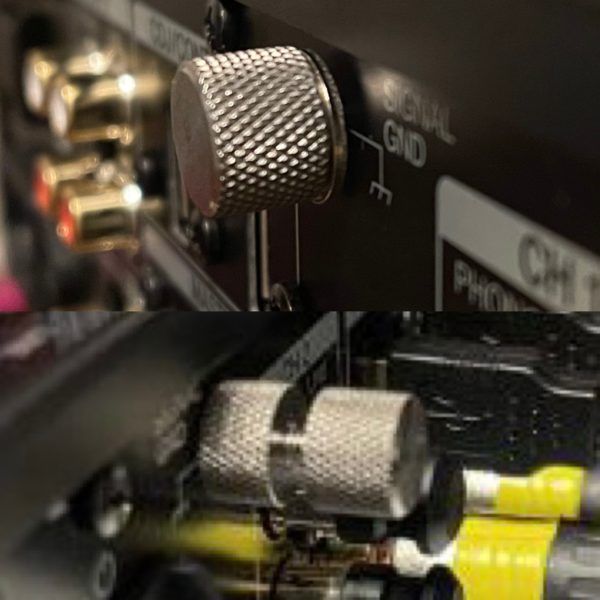
The grounding screws on the S7 are annoying – though granted, not as much as the grounding screws on their club mixers. For whatever reason, they decided to forgo the extra space on the base of the screws. This puts the base of the screw a lot closer to the backplate than the S9. Unfortunately, there’s a little bit of a recessed lip right where the screws are connected. This makes attaching a grounding fork a bit of a pain.
Loop MIDI in Practice
Ultimately, the reduced effect buttons and Serato’s still-early implementation of MIDI mapping let the feature down a little. While you can do some amazing stuff, it requires so much prep and memorization that it may go ignored by a lot of DJs. The lack of documentation and/or tutorial material available as of this review’s writing doesn’t help, either. I’m hoping this will change in the future.
For me, I played with it for a week or so, saying: “This is so cool!” – then proceeded to use it rarely after that. It’s definitely something that rewards diligent and experimental users. However, many will probably not have the patience to explore beyond the default settings.
Shift Button Placement
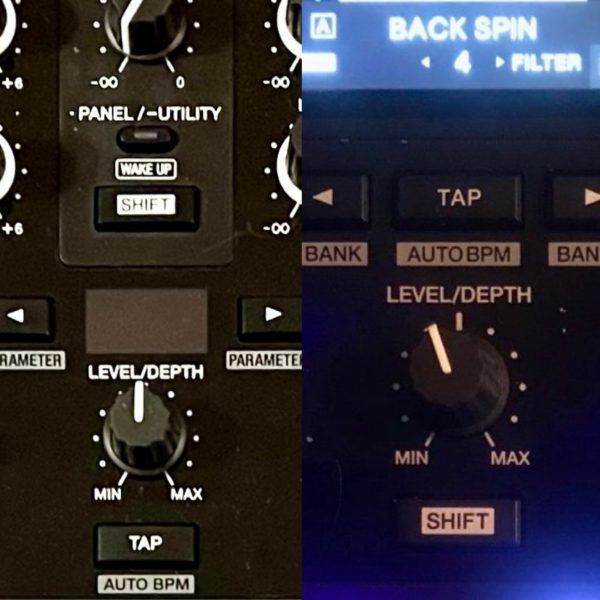
Unlike many, I have somewhat limited experience with the S9. While I have used the mixer many times over the years, it was always at certain venues rather than my personal mixer. On the other hand, I had several months to work with the S11 as my primary mixer. Given the closer proximity to the pads, I firmly believe that the S11 shift button placement is far superior. I understand Pioneer DJ is trying to keep the familiarity of the DJM-S9 layout, but I would prefer swapping the Shift for the Tap button on the DJM-S7.
Lack of Silent Cue
I expect Silent Cue on every Serato scratch mixer above a certain price tag these days. Even having it as one of the Loop MIDI controls would have been great (did we really need 4 sampler triggers in Loop MIDI?).
I know the Gated Cue is the expected alternative – and it works for the most part. It just doesn’t feel as organic or simple as using the proper Silent Cue controls.
Resourceful users should figure out how to edit the code into the XML file fairly easily.
Tone Control on Mic
I realize that they are lacking in space, but I will always prefer a 2-band EQ to a tone control knob.
No Split Cue
Like the S11, the lack of split cue is a major oversight. I hope they start to include this on their mixers moving forward.
Final Thoughts
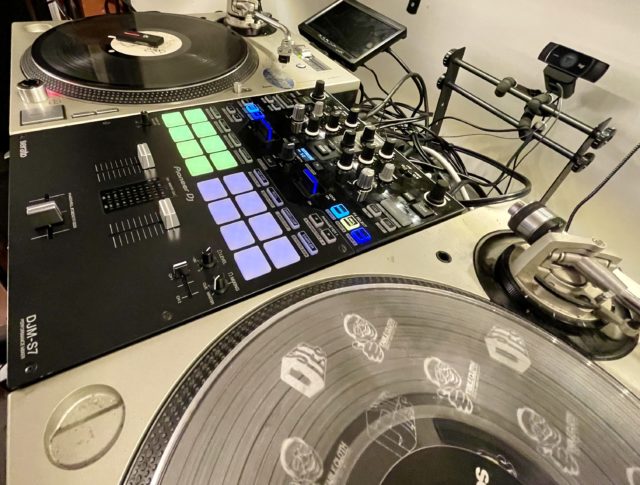
At its core, the DJM-S7 is a great mixer and overall, a worthy successor to the DJM-S9. It’s a solid, straight-forward mixer that will undoubtedly delight mix and battle DJs alike with its intuitive and easy-to-navigate workflow, powerful effects suite, and the standout crossfader. That said, it is not without its caveats. I found some of the decisions slightly frustrating as I was expecting a more direct update to the DJM-S9.
How does it compare to the DJM-S9?
Given that 7 is a smaller number than 9 and comes with a lower price tag, it may lead some to believe it sits lower than the S9 in capabilities. That would be the furthest thing from the truth, though. Looking at it from a feature-for-feature perspective, it is objectively superior to the DJM-S9. With the improved hardware effects, better software effect controls, improved sound quality, unique Loop MIDI mode, Bluetooth capability, and the far superior pad functionality, there’s a lot that the DJM-S7 offers over the DJM-S9.
However, the DJM-S7 ultimately feels like 2 steps forward and 1 step back when compared to the S9. The lack of the extra effect buttons hurts the usability of all these extra features. Likewise, the loss of some features does hurt this mixer a bit. Not being able to apply effects to the AUX and especially the Sampler channel, the loss of some mic features, and the overall cheaper feel to the mixer keeps this from being a “true” successor.
I think those expecting a proper S9 MK2 will be a bit disappointed. Some compromises range from trivial to downright disappointing. Pioneer DJ could have kept the S9 design for the effect buttons, included all the same features as the S7, sold it for the same price as the S9, and made an absolute killing. Instead, we have something that is almost – but not quite – a better version of the DJM-S9.
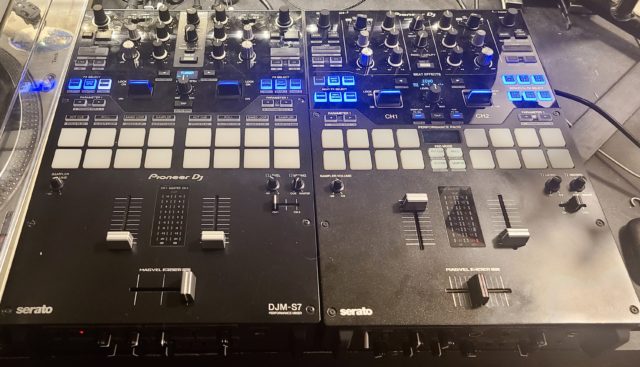
Is it worth switching over to the S7?
Should you sell your DJM-S9 for the DJM-S7? It depends on how important the pads, the sound quality improvement, and whether the hits to the build and effects workflow are dealbreakers or not. For me: absolutely. The unified pad controls on the S9 were always a major issue for me – as was the problematic sound quality. I never considered purchasing the S9 for those reasons. The S7, on the other hand, fits my play-style almost perfectly.
Would I sell a Rane Seventy or a Reloop Elite for the DJM-S7? Unless you are one of those Pioneer DJ #1 types or absolutely need that effects section or crossfader, probably not. It feels like more of a lateral move to those mixers. It does some things better but falls short at others, and I wouldn’t think it would warrant the loss incurred.
For those looking to finally upgrade from that old Rane Sixty-Two, Z2, or even the 57 – or those just getting into the 2 channel Serato mixer world – the DJM-S7 is worth a look.
Who is it for?
- Fans of the DJM-S9
- Scratch/Battle DJs
- Hip Hop and Open Format DJs
- Those looking for a more straightforward alternative to the DJM-S11 or Rane Seventy-Two
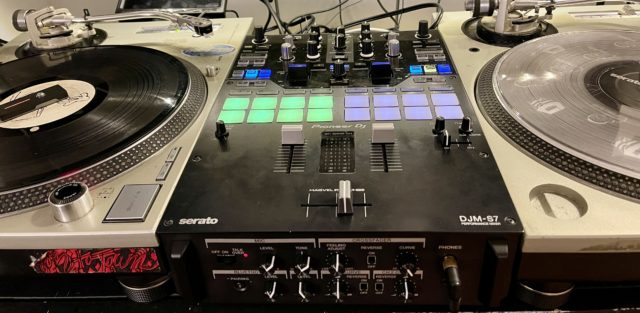
The DJM-S7 adds another shot in the escalating arms race between Pioneer DJ and InMusic (and whoever else dares enter the fray, like Reloop). While it’s not exactly the DJM-S9 MK2 that many were hoping for, the DJM-S7 is a capable entry into an increasingly competitive market.
Is the DJM-S7 a game-changer like the DJM-S11 or even the DJM-S9 before it? Not really. It’s more a revision of a proven formula rather than something that reinvents the wheel – and that’s absolutely fine. It offers a compelling and modern option that excels at that signature Pioneer DJ workflow at a competitive price point, all while adding a sprinkling of innovation as icing on the cake.
How do you think the DJM-S7 stacks up? Let us know your thoughts in the comments. And if you’re after a unit – it’s available in the DJTT shop for $1,399.





